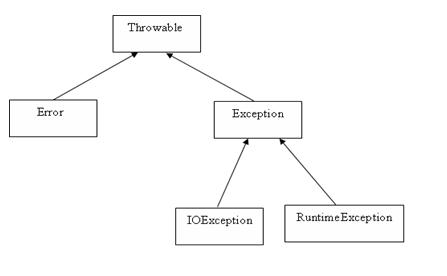Java 异常处理
所有的异常类是从 java.lang.Exception 类继承的子类。
Exception 类是 Throwable 类的子类。除了Exception类外,Throwable还有一个子类Error 。
Java 程序通常不捕获错误。错误一般发生在严重故障时,它们在Java程序处理的范畴之外。
Error 用来指示运行时环境发生的错误。
例如,JVM 内存溢出。一般地,程序不会从错误中恢复。
异常类有两个主要的子类:IOException 类和 RuntimeException 类。

捕获异常
使用 try 和 catch 关键字可以捕获异常。try/catch 代码块放在异常可能发生的地方。
try/catch代码块中的代码称为保护代码,使用 try/catch 的语法如下:
import java.io.*; |
结果:
Exception thrown :java.lang.ArrayIndexOutOfBoundsException: 3 |
throws/throw 关键字
如果一个方法没有捕获到一个检查性异常,那么该方法必须使用 throws 关键字来声明。throws 关键字放在方法签名的尾部。
也可以使用 throw 关键字抛出一个异常,无论它是新实例化的还是刚捕获到的。
下面方法的声明抛出一个 RemoteException 异常:
import java.io.*; |
finally 关键字
finally 关键字用来创建在 try 代码块后面执行的代码块。
无论是否发生异常,finally 代码块中的代码总会被执行。
在 finally 代码块中,可以运行清理类型等收尾善后性质的语句。
finally 代码块出现在 catch 代码块最后,语法如下:
public class ExcepTest{ |
结果:
Exception thrown :java.lang.ArrayIndexOutOfBoundsException: 3 |
异常对象方法
getMessage()函数:输出错误性质
toString()函数:给出异常的类型与性质
printStackTrace()函数:指出异常的类型、性质、栈层次及出现在程序中的位置
参考
https://www.runoob.com/java/java-exceptions.html?tdsourcetag=s_pcqq_aiomsg


